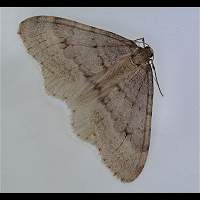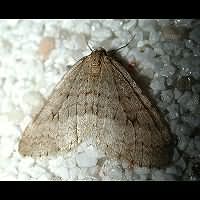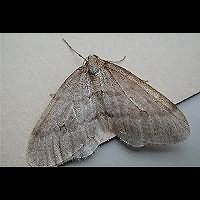Northern Winter Moth (Alsophila aescularia)
The Northern Winter Moth is rather a sad case. The male is almost identical to that of the Winter Moth and the two species are asily mixed up. Yet they can be told apart. It helps to have seen them together once. Compared to the Winter Moth the Northern Winter Moth often is even less marked, it is larger, the colour is greyish and lighter, it is glossy and the wings are shaped differently: at the base, called the shoulder in moths, they run stright for a few millimetres, before curving down. The tips of the wings are sligtly rounder and the hind wings are whitish. It is rarely found with the wings in an upright position and in general is much scarcer. The wingspan is some 32 to 40 mm. The females can't fly. Contrary to the females of the Winter Moth they do have small wings. These are clearly marked: a dark band runs over them. This makes the females easy to identify.
The eggs are mainly laid in November and they overwinter. In spring the caterpillar appears to eat the growing leaves. The larva is (blueish) light green. On top runs a narrow dark green line. Along the sides run three whitish lines, of which the first is thick. The head is brown showing some lighter markings. It will reach a length of some 27 mm. In June the caterpillar moves to the ground, digs a hole and pupates there. New moths appear from October onward. Accidentally moths appear in August and September. The Northern Winter Moth is found on Birch mainly, but also on Alder and Beech. Every now and then it is found on fruit trees, especially Apple, Plum and Cherry.
Even though it may be seen from August to February, it usually just flies from mid-October to mid-November. By doing so it flies earlier than the Winter Moth. The adults do not feed themselves anymore. The males are easily attracted to lights and will not hesitate to enter the house. Males and females are sometimes seen resting on tree bark during the day, often sitting close together. Quite common in England, Less frequent, but widespread in Wales and Scotland. Probably not an Irish species. Elsewhere in Europe widespread, but often a very local species.
The Northern Winter Moth is rather a sad case. The male is almost identical to that of the Winter Moth and the two species are asily mixed up. Yet they can be told apart. It helps to have seen them together once. Compared to the Winter Moth the Northern Winter Moth often is even less marked, it is larger, the colour is greyish and lighter, it is glossy and the wings are shaped differently: at the base, called the shoulder in moths, they run stright for a few millimetres, before curving down. The tips of the wings are sligtly rounder and the hind wings are whitish. It is rarely found with the wings in an upright position and in general is much scarcer. The wingspan is some 32 to 40 mm. The females can't fly. Contrary to the females of the Winter Moth they do have small wings. These are clearly marked: a dark band runs over them. This makes the females easy to identify.
The eggs are mainly laid in November and they overwinter. In spring the caterpillar appears to eat the growing leaves. The larva is (blueish) light green. On top runs a narrow dark green line. Along the sides run three whitish lines, of which the first is thick. The head is brown showing some lighter markings. It will reach a length of some 27 mm. In June the caterpillar moves to the ground, digs a hole and pupates there. New moths appear from October onward. Accidentally moths appear in August and September. The Northern Winter Moth is found on Birch mainly, but also on Alder and Beech. Every now and then it is found on fruit trees, especially Apple, Plum and Cherry.
Even though it may be seen from August to February, it usually just flies from mid-October to mid-November. By doing so it flies earlier than the Winter Moth. The adults do not feed themselves anymore. The males are easily attracted to lights and will not hesitate to enter the house. Males and females are sometimes seen resting on tree bark during the day, often sitting close together. Quite common in England, Less frequent, but widespread in Wales and Scotland. Probably not an Irish species. Elsewhere in Europe widespread, but often a very local species.






